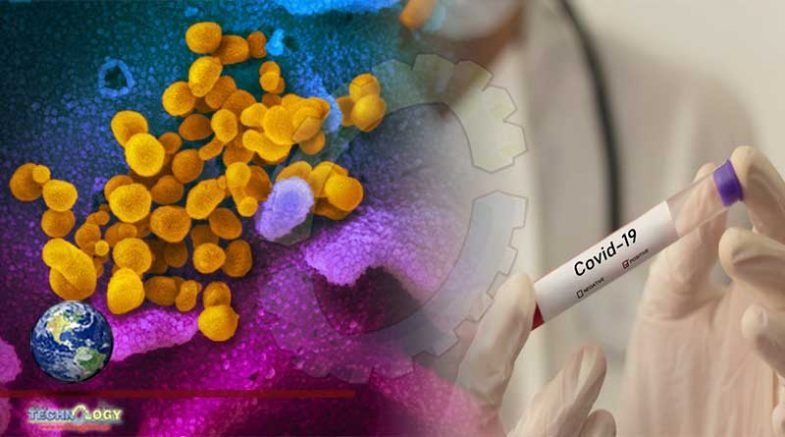Presence of residual SARS-CoV-2 viral antigens in pulmonary tissues from patients recovering from the coronavirus disease 2019 (COVID-19).

A team of researchers in Singapore, led by Dr. Joe Yeong, and Prof. Tony Kiat Hon Lim, have reported the presence of residual SARS-CoV-2 ribonucleic acid (RNA) – the virus’ genetic material – in stool samples and gastrointestinal tissues from patients recovering from the coronavirus disease 2019 (COVID-19).
Enteric involvement of the severe acute respiratory syndrome coronavirus 2 (SARS-CoV-2) is already known. However, the detection of the viral antigens within gastrointestinal and hepatic organs ‘during the convalescent phase’ has, until now, not yet been reported.
COVID-19 was declared a pandemic by the World Health Organization (WHO) in March 2020. SARS-CoV-2 was first detected in Wuhan, China, in late December 2019. Since then, it has infected over 50 million people, claiming over 1.25 million lives.
Expeditious investigations on this disease are being carried worldwide to better understand the virus, find a treatment drug or strategy, curb its transmission, and develop safe healthcare policies. The direct infection of the gastrointestinal organs and its consequential fecal-oral transmission route is a serious concern for COVID-19 pathology.
In this context, the research team from Singapore investigated the presence of SARS-CoV-2 virus particles in intestinal and liver tissues and the SARS-CoV-2-specific immunity; they have reported their illuminating findings in a recent medRxiv* preprint paper.
The study cohort consists of 2 COVID-19 patients – both middle-aged men, diagnosed with COVID-19, from which they have recovered. Patient 1 underwent laparoscopic right hemicolectomy (for a large circumferential malignant mass in the colon).
Patient 2 had a significant medical history of chronic hepatitis B virus-related liver cirrhosis and segment VII hepatocellular carcinoma (HCC). He underwent curative resection of HCC.
Colon, ileum, appendix, and lymph nodes tissues were removed during surgery from patient 1, while liver tissues were removed from patient 2.
Using immunohistochemistry, the researchers detected SARS-CoV-2 nucleocapsid from intestinal and liver tissues in both the patients. The SARS-CoV-2 nucleocapsid and angiotensin-converting enzyme 2 (ACE2) receptor were in close proximity. They also found SAR-CoV-2 spike protein (or S-protein). However, the viral RNA – detected by reverse transcription-polymerase chain reaction (RT-PCR) testing – was not present in liver tissues, possibly because of the long recovery period.
Although many post-mortem studies have shown SARS-CoV-2 in various organs, the findings from patients with mild COVID-19 are distinct from these post-mortem studies; patients who succumbed to COVID-19 had a more severe disease course and thus might not be representative of the general population. Unlike, as in this case of the two patients here, these men suffered from mild infection and recovered a few months before this study.
The researchers performed ex vivo peptide stimulation assays involving a cocktail of the viral nucleocapsid, spike, and membrane proteins to examine SARS-CoV-2-specific immunity in the tissues from recovered patients. Results show that SARS-CoV-2-specific CD38+Granzyme B+CD4+ T cells were elicited, suggesting that SARS-CoV-2-specific memory T-cells may be maintained in both tissue and blood – approximately three months into recovery; this finding is the first report.
The SARS-CoV-2 viral particles have been detected in patients’ respiratory tracts recovered from COVID-19 – raising concern for potential virus reservoirs.
“Together, it seems that SARS-CoV-2 might be cleared in the digestive tract later than in the respiratory tract. Therefore, a negative nasopharyngeal swab result might not necessarily indicate complete viral clearance from the body.”
This study is the first report of detecting the SARS-CoV-2 antigens in non-pulmonary tissues in clinically recovered COVID-19 patients. Conducted in a non-postmortem setting, it presents an important preliminary investigation that throws light on the caution required around COVID-19 recovered patients and disease management plans. Further investigations are required to test if the viral antigens are infectious – its competence and stability in the environment and the abundance in shedding.
“We propose caution when handling tissues from patients who have a recent history of COVID-19, particularly during aerosol-generating procedures such as ultrasonic dissection surgery.”
The prevalence and prognosis of the SARS-CoV-2 viral antigens involvement in daily life are mostly unknown. This first evidence of the presence of RNA particles in recovered COVID-19 patients might have implications in public health policy regarding the transmission of COVID-19 infection besides the respiratory route.
Originally published at News-medical
